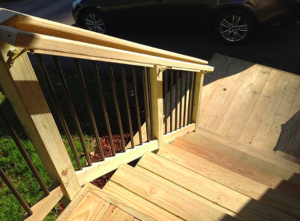
Pressure-treated wood has its pros and cons for decks.
Adding a deck to your yard or property is a great way to get more useable space out of your home. A well-made deck could easily become an outdoor kitchen or eating area or even just an entertaining space. But the key to a well-made deck is a combination of materials and craftsmanship. When looking at decking materials, you will almost always come down to three or four broad choices, the most common of which is pressure-treated lumber (composite and vinyl being two other common choices). Read on to learn more about the value of pressure-treated wood for decks.
What Does Pressure-Treated Mean?
Pressure-treating is the process of adding chemicals to a wood product or cut to make it more resistant to rot and insect damage. This is most commonly done with pine, specifically Southern Yellow Pine, and the chemicals are infused into the cut wood through intense pressure (which is quicker than older soaking methods).
Where Is It Used?
Pressure-treated wood is used for outdoor structures such as decks, pergolas, and fencing. Pretty much any outdoor project that will be exposed to the weather is an ideal candidate for pressure-treated wood (unless you will be eating on it). It is not a good material choice for indoor uses since it can out-gas for a while.
What Are Its Advantages?
Pressure-treated wood offers numerous benefits, but being rot and insect resistant are its biggest. Pressure-treated wood also often comes with a warranty that non-treated wood won’t have. It is also usually substantially less expensive than the other materials you might use for outdoor projects, like composite or cedar. Pressure-treating allows you the ease and cost savings of using pine without the risk that it will rot away or be attacked by bugs. Pressure-treated wood is even approved for ground contact.
What Are Its Disadvantages?
Pressure-treated wood still needs to be maintained to live up to the many years of use it is capable of. This includes painting, staining, or sealing it yearly. It’s a lot of work, but it pays for itself in the decades of use you will get. Pressure-treating is also harmful to the environment (though less so than it used to be) because of the chemicals used. Those chemicals can also contribute to the grey discoloration of the wood over the years in response to UV damage. Finally, pressure-treating doesn’t completely protect against all damage, especially checking – the splits that happen when water in the pores of the wood goes through the freeze and thaw cycle.
Upgrade Your Home and Reach Out to Freedom Fence Today
Whether you want a brand new patio in the spring or want to install a beautiful new wood fence, Freedom Fence and Home has the expertise, competitive prices, and professional service you need. Freedom Fence and Home has over 50 years of fencing experience in the Baltimore County area, Harford County, Essex, White Marsh, and Bel Air area, and we pride ourselves on giving our customers the best customer service experience possible. To see examples of our work and pick the right fence for your home, visit us online. To get started on planning your project, give us a call at (443) 271-6841, or visit us online. For more information, tips, and updates about Freedom Fence and Home, follow us on Twitter, Pinterest, and Facebook.
